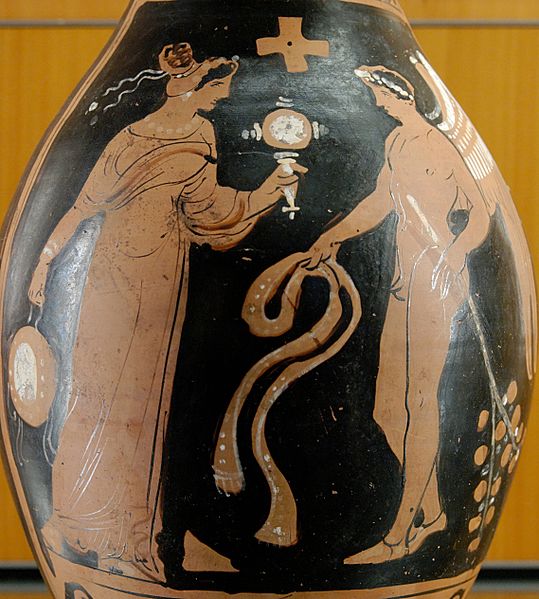Agathos Daimon originally was a lesser deity (daemon) of classical ancient Greek religion and Graeco-Egyptian religion. In his original Greek form, he served as a household god, to whom, along with Zeus Soter, libations were made after a meal. In later (post-)Ptolemaic antiquity he took on two partially distinct roles; one as the Agathos Daimon a prominent serpentine civic god, who served as the special protector of Alexandria. The other as a genus of serpentine household gods, the Agathoi Daimones, individual protectors of the homes in which they were worshipped.
Agathos Daimon wearing a pschent, the double crown of Egypt, holding a thyrsus (left) and a caduceus (right)
Copper statuette of the god Sarapis Amun Agathodaemon. National Archaeological Museum, Athens
Coin of Antoninus Pius, 160 AD from Alexandria, Egypt. On the reverse to the left, a serpent portrayal of Agathodaimon; to the right, a portrayals of an Uraeus serpent.
The Ancient Greek: δαίμων, pronounced daimon or daemon, originally referred to a lesser deity or guiding spirit such as the daimons of ancient Greek religion and mythology and of later Hellenistic religion and philosophy.
The word is derived from Proto-Indo-European daimon "provider, divider ," from the root *da- "to divide". Daimons were possibly seen as the souls of men of the golden age acting as tutelary deities, according to entry δαίμων at Liddell & Scott. See also daimonic: a religious, philosophical, literary and psychological concept.
Gold ring with Sitting Goddess and row of Minoan Genius figures bearing offerings, found in context from Mycenaean Greece, but probably made in Minoan Crete, NAMA
Carnelian gem imprint representing Socrates, Rome, first century BC – first century AD
Winged genius facing a woman with a tambourine and mirror, from southern Italy, about 320 BC






